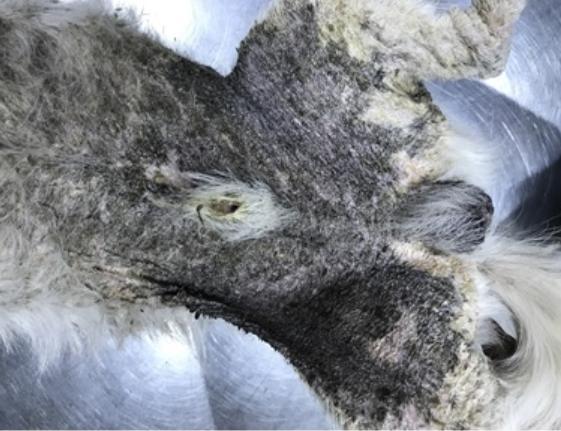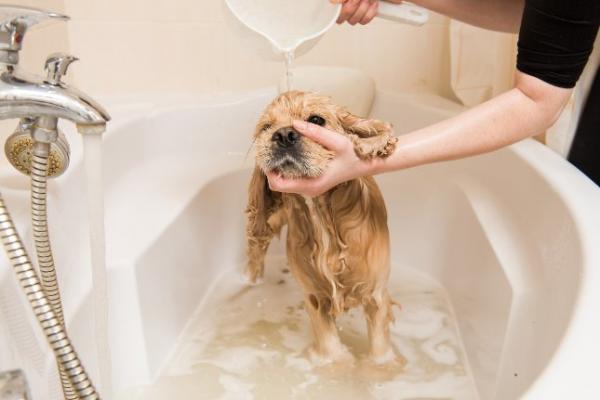Ichthyosis in Dogs - Symptoms and Treatment



See files for Dogs
Ichthyosis is a skin disease that is known for its hardening of the skin. This seborrheic condition causes grey scales to appear, but it can result in secondary infections, blisters, onychogryphosis and hyperkeratosis.
It is a fortunately rare disease, but it does affect puppies more than adult dogs. Certain breeds are more predisposed to ichthyosis than others as they are carriers of genes which influence the onset of the condition. At AnimalWised, we share more information on ichthyosis in dogs, paying special attention to its symptoms and treatment.
What is ichthyosis in dogs?
Ichthyosis is a dermatological problem that can affect dogs, although it can occur less frequently in cats. As a seborrheic disease, it results in characteristic scaly lesions on the skin. However, it should not be confused with seborrhea in dogs. These lesion undergo desquamation on the skin and paw pads, meaning the outer layer of skin is shed.
It is worth mentioning that it is a rare disease that it is usually evident from birth, affecting young dogs in their first months of life.
Types of ichthyosis in dogs
Ichthyosis can be of grouped into two main types:
- Epidermolytic ichthyosis: appears in the youngest puppies from birth. Blisters form on the skin.
- Ichthyosis vulgaris: thick and dry scales appear more frequently on the skin. Sometimes it can manifest as very dry skin if it is only a minor case. It can occur after birth or in the first months of life.
Source: Veterinariargentina

Symptoms of canine ichthyosis
During the first months of the puppy's life, grayish dandruff begins to be shed all over the skin. However, the abdomen is usually most affected. The skin is also dry and can darken in certain areas, especially the thighs or the belly. Other signs of ichthyosis in dogs are:
- Thickened skin (specifically, the epidermal granular layer)
- Skin hyperpigmentation
- Paw pad hyperkeratosis
- Hyperkeratosis of the nasal plane
- Gray scales on the skin which can flake off
- Smelly seborrhea
- Onychogryphosis (abnormal increase in nail plate growth)
- Secondary infections by the Malassezia fungus
When the nail plate grows abnormally, it can hook round and make their walk uncomfortable. Although the dog will have flaky skin, it can also look quite greasy.
Causes of ichthyosis in dogs
Ichthyosis in dogs usually has a genetic cause. For this reason, certain breeds pass on the gene associated with ichthyosis more than others. These breeds include:
- West Highland White Terrier
- Cavalier King Charles Spaniel
- Golden Retriever
- Pinscher
- Jack Russell Terrier
- Yorkshire Terrier
Golden Retrievers are the breed most predisposed to ichthyosis and therefore can spread the gene to their offspring, even if the latter are a mixed breed. Around 50% of the Golden Retrievers in Europe carry this genetic mutation.
A DNA test from an oral smear identifies those that possess it. This can help to prevent them from crossing and preventing their transmission to puppies, limiting the spread of the disease in dogs. Even dogs which present no symptoms of the disease can spread it to their young.
We share more information in our article on things you didn't know about Golden Retrievers.
Diagnosis of ichthyosis in dogs
The diagnosis of canine ichthyosis is based on both a dermatological diagnosis and a histological diagnosis by biopsy. To obtain the correct diagnosis, the following tests will be carried out:
- Cytology: the lesions will be observed and a cytology will be performed for its visualization under the microscope. Ichthyosis should be suspected when a young puppy has severe scaling, scabs, seborrhea and, especially, hyperkeratosis. If we see gray scabs from birth, it is likely. It must be differentiated from other more frequent dermatological diseases of dogs such as atopic dermatitis.
- Biopsy: a biopsy of the lesion must be examined, taking a sample of the affected skin tissue to be sent to the laboratory. Histology will show if we are definitely facing this problem.
- DNA test: the diagnosis can also be achieved with a DNA test by oral smear. As it is a congenital disease, the best way to prevent the disease in the offspring is to avoid the reproduction of carrier dogs. This can be easily achieved through sterilization. In addition, sterilizing your pet will help prevent diseases of the reproductive system, such as tumors, improve behavioral problems such as aggression, and can even improve their life expectancy.
Treatment of ichthyosis in dogs
Ichthyosis has no cure, but symptom management can help the control to develop a good quality of life. We must bear in mind the disease is lifelong, so this management will be permanent. If we ignore any of these problems, the lesions will reappear. Treatment will consist of the following:
- Hydration: due to the dryness and crusty appearance of the skin, hydration is extremely important. This means they will need to hydrate internally by drinking plenty of water, as well as using hydrating topical products to condition our dog's skin and hair. The moisturizing properties we need to look for include glycerin, propylene glycol or urea.
- Diet rich in fatty acids: omega 3 and omega 6 fatty acids are key to healthy skin and coat, so they should be consumed in good quantities in dogs with ichthyosis. The diet must be naturally rich in these fatty acids, but your veterinarian may recommend supplements if necessary. Always discuss with your veterinarian before administering any type of supplement.
- Special shampoo: they should be bathed with special shampoos for this type of skin and more frequently than dogs usually need bathing, i.e. at least once a week. Once the bath is finished, moisturizing ointments or creams should be applied.
- Avoid extreme temperatures: sunburn or extreme cold should be avoided, as these dogs have more sensitive skin and it could worsen the condition.
- Antibiotics or antifungals: if they have secondary bacterial infections, antibiotics will be used. If the infections are caused by a fungus such as Malassezia, antifungals such as itraconazole or ketoconazole may be prescribed.
- Keratolytic agents: if they have developed hyperkeratosis in dogs, this overproduction of the stratum corneum (the outermost layer of skin) should be reduced with keratolytic agents that will stop excessive production of keratin. We will also need to use emollients and moisturizers to soften the skin.
For more information on diseases of the skin in canines, take a look at our related article on skin tumors in dogs.

This article is purely informative. AnimalWised does not have the authority to prescribe any veterinary treatment or create a diagnosis. We invite you to take your pet to the veterinarian if they are suffering from any condition or pain.
If you want to read similar articles to Ichthyosis in Dogs - Symptoms and Treatment, we recommend you visit our Skin problems category.
- Harvey, R. G., & Mckeever, P. J. (2001). Illustrated Manual of skin diseases in dogs and cats. GRASS Edicions.
- Ferrer, S. (2020). Ichthyosis in dogs: a serious skin disease. How to train a puppy. Retrieved from: https://comoeducarauncachorro.com/blog/ictiosis-en-perros-una-enfermedad-de-la-piel-grave.html
- Rivers, A. (2006). Ichthyosis in two golden retriever dogs. National Congress of Avepa. Retrieved from: https://ddd.uab.cat/pub/clivetpeqani/11307064v26n4/11307064v26n4p342.pdf







